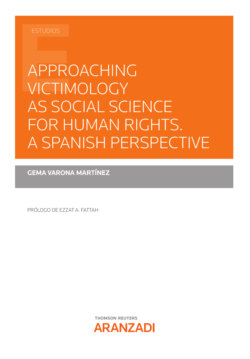Читать книгу Approaching Victimology as social science for Human rights a Spanish perspective - Gema Varona Martínez - Страница 28
На сайте Литреса книга снята с продажи.
III Public policies for victims and the role of the media: activism and victimism 1. VICTIM ACTIVISM AND VICTIM POLICIES 1.1. VICTIM ACTIVISM, MEDIA AND PARTISAN MANIPULATION RISK
ОглавлениеRemembering Becker’s remarks on minimum objectivity (1965) and the need for a critical perspective in social science, Victimology should be understood as something different from victim activism (Fattah, 2006). Despite the slow advancement in taking into account victims’ needs and rights, thanks to victim activism, victim support services have been created and victims’ rights have been brought to the fore in the criminal justice system, with greater or lesser success (Cerezo, 2011).
Image 14: Origin and development of general (private and public) victim support services. Source: Victim Support Europe (2018)
Image 15: Victim support; European standards
In 1990 in Stockholm, Sweden, Victim Support Europe declared 22 February to be the European Day for Victims of Crime to raise awareness of help and support of victims as well as their relatives. Today, there are specific international and European days for specific victimisations (violence against women, terrorist victimisation, sexual victimisation, road traffic violence etc.)1.
Image 16: European Day of Victims of Crime. Source: https://victimsupport.scot
According to Victim Support Europe2 (VSE), established in 1990, this organisation promotes the establishment and development of victim rights and services throughout Europe. The organisation aims to ensure that every victim in Europe and worldwide can access information and support services in the aftermath of a crime, regardless of where the victim lives or where the crime took place and regardless of whether or not the crime is reported to the police. Victim Support Europe also works to ensure that victims are respected, have access to other rights and can make their voice heard throughout the criminal justice process. VSE supports the development of victim support services that are: free of charge; confidential; victim-centred; independent; accessible throughout Europe; tailored to meet the individual needs of the victim; and delivered by trained and qualified staff/volunteers. Victim Support Europe monitors and influences the adoption of EU legislation and policies that impact the rights of victims of crime.
Some criminal law professors and academicians contend that the rise of victims’ movements (of support and self-help) might be leading to more punitive criminal policies because the victims’ interests are being manipulated towards more repressive laws. However, there is evidence that victims are not more punitive than the general population and that they also have prosocial concerns towards the offender and the community (Van Camp, 2017). Contrary to the general basic assumption on victims’ punitivism, their participation in the criminal justice system might make it less punitive and, perhaps, more restorative (Brennan and Johnstone, 2019). In any case, any assessment on this topic has to be done distinguishing different victimisations, contexts and countries (Kunst, 2021).
According to international standards, the victims’ claims to participate in the criminal justice system have a reasonable and legal basis and the key questions are how that participation should be made more adequate in procedural and substantive terms at different moments of the process and what is happening in practice after legal reforms have entered into force.
Article 26.2 of the 2012/29/EU Directive refers to cooperation with relevant civil society organisations and other stakeholders. As we will see in Chapter 5, the European Commission on 24 June 2020 adopted its first-ever EU strategy on victims’ rights (2020-2025). The main objective of this strategy is to ensure that all victims of all crime, no matter where in the EU or in what circumstances the crime took place, can fully exercise their rights. To that end, it outlines actions that will be conducted by the European Commission, Member States and civil society.
This strategy is based on a two-strand approach:
• empowering victims of crime and
• working together for victims’ rights.
The strategy presents five key priorities:
• effective communication with victims and a safe environment for victims to report crime;
• improving support and protection to the most vulnerable victims;
• facilitating victims’ access to compensation;
• strengthening cooperation and coordination among all relevant actors; and
• strengthening the international dimension of victims’ rights.
The EU Strategy mentions the promotion of victim support organisations to “engage with national authorities, including judicial and law enforcement authorities, and participate in mutual training activities”.
